Can you grow a banana plant indoors and still get lush, large leaves? There are over 1,000 banana types worldwide. To start, learn about banana plant care, like watering and the right conditions.
For example, banana plants need full sun and well-draining soil. You can find more tips on a reliable houseplant guide.
Indoor banana plants can grow up to 30 feet tall. But, dwarf varieties stay around 10 feet. With the right care, you can enjoy these plants at home.
Learn about your plant’s needs, like watering and fertilizing. This way, you can grow a healthy banana plant indoors.
Understanding Your Banana Plant
Exploring banana plant care is exciting. There are over 1,000 types, each special in its own way. You can pick the best one for your home. Knowing what your plant likes is key, like temperature, humidity, and light.
Popular banana plants include the Dwarf Cavendish and Musa acuminata. They have big leaves and can grow tall. Make sure they get 6 hours of sunlight a day and keep the air moist.
Origins and Varieties of Banana Plants
Banana plants come from Southeast Asia. There are many to choose from. Some are small, perfect for indoors, while others grow big and need more room.
The Unique Appeal of Banana Plants
Banana plants are great for cleaning the air and making your home look tropical. Knowing about different banana plants helps you care for them well. It’s fun for both new and experienced gardeners.
Important banana plant care tips include:
- Give them enough light and moisture
- Keep the temperature steady
- Fertilize often when they’re growing
- Prune and repot when needed
Follow these tips to help your banana plant grow well. Enjoy its many benefits.
Ideal Growing Conditions for Banana Plants
To make your banana plant happy, give it the right home. They love full sun to partial shade. This means they do well in south-facing windows or sunrooms.
Banana plants need lots of sunlight. They should get at least 6 hours of direct sun each day.
For banana plant care, keep the temperature and humidity just right. They like it warm, between 75 to 95 degrees Fahrenheit. The humidity should be between 30-40% or higher indoors.
Light Requirements for Healthy Growth
Banana plants can grow really tall, up to 12 to 20 feet. Their leaves can get as long as 2 meters. They need lots of light to grow big and strong.
Here are some tips for the right light:
- Put your banana plant in a south-facing window or sunroom for direct sunlight.
- Use grow lights to help with natural light, especially in winter.
- Keep your banana plant at least 3 feet away from windows to avoid too much heat.
Optimal Temperature and Humidity Levels
To make a perfect home for your banana plant, keep the temperature and humidity just right. Here’s what you need:
| Condition | Ideal Level |
|---|---|
| Temperature | 75-95°F (24-35°C) |
| Humidity | 30-40% or higher |
Choosing the Right Pot for Your Banana Plant
Choosing the right pot is key for your banana plant’s health. The size and material of the pot matter a lot. A small pot can stop the plant from growing. A big pot can make the soil too wet.
It’s important to pick a pot with holes for water to drain. This stops root rot and lets the plant get the right water. You can choose from clay, terracotta, plastic, or ceramic pots.
Pot Size and Material Considerations
Start with a pot 2-3 inches bigger than the nursery one for young plants. As it grows, move to a slightly bigger pot. The best size is 12 to 18 inches wide.
How to Ensure Proper Drainage
Drainage holes are key to stop root rot. Make sure to keep these holes clear. This lets water flow and stops the soil from getting too wet. Clay or terracotta pots are good because they breathe, but you might need to water them more.
Here are some things to think about when picking a pot for your banana plant:
- Pot size: 12 to 18 inches in diameter
- Pot material: clay, terracotta, plastic, or ceramic
- Drainage holes: essential for preventing root rot
- Watering: frequency depends on pot material and size
| Pot Material | Advantages | Disadvantages |
|---|---|---|
| Clay or Terracotta | breathable, reduces root rot risk | may require more frequent watering |
| Plastic | retains moisture, lightweight | can lead to overwatering if drainage is inadequate |
| Ceramic | aesthetically pleasing, heavy | can break easily |
Soil for Banana Plant Care
Choosing the right soil is key for banana plants to grow well and produce fruit. You need a soil that drains well and is rich in organic matter. A mix made for tropical plants works best.
For banana plants, the soil’s pH should be between 5.0 and 6.5. This means it’s slightly acidic. You can make your own mix with peat moss, compost, and vermiculite. This mix helps keep the soil moist and absorbs nutrients well.
It’s also important to test the soil’s pH often. This is because tap water can make the soil too alkaline.
- Using a well-draining potting mix to prevent waterlogged soil
- Adding organic matter like compost to improve soil structure and fertility
- Avoiding overwatering, which can lead to root rot and other problems
By following these tips and using the right soil mix, you can give your banana plant the best chance to grow and produce fruit. Regular fertilization also helps with healthy growth and fruiting.
Watering Your Banana Plant
Watering your banana plant right is key for its health. You need to know how often to water it. This depends on your home’s humidity and temperature.
Watering once a week is usually enough. But, this can change with the seasons.
In summer, your banana plant might need more water. Water it once a week then. In winter, you can water it every two weeks. Always check the soil to see if it’s time to water.
How Often to Water
Keep the soil moist but not too wet. Stick your finger into the soil up to the first knuckle. If it’s dry, it’s time to water.
Signs of Overwatering and Underwatering
Too much water can cause root rot. Not enough water can make leaves dry and brittle. Check the soil often to avoid these problems.
For a healthy banana plant, use a potting mix that drains well. Also, avoid getting water on the leaves to prevent diseases. With the right care and watering, your banana plant will thrive.
Nutrition and Fertilization
As you care for your banana plant, remember to focus on banana plant fertilization. This helps your plant grow well and produce fruit. Use a fertilizer that has lots of nitrogen, phosphorus, and potassium. For more tips, check out trusted houseplant guides on banana plant care.
For the right fertilizer, pick a balanced one like 15-15-15. This gives your banana plant the nutrients it needs. Young plants need food every month. But, older plants do better with food every two weeks.
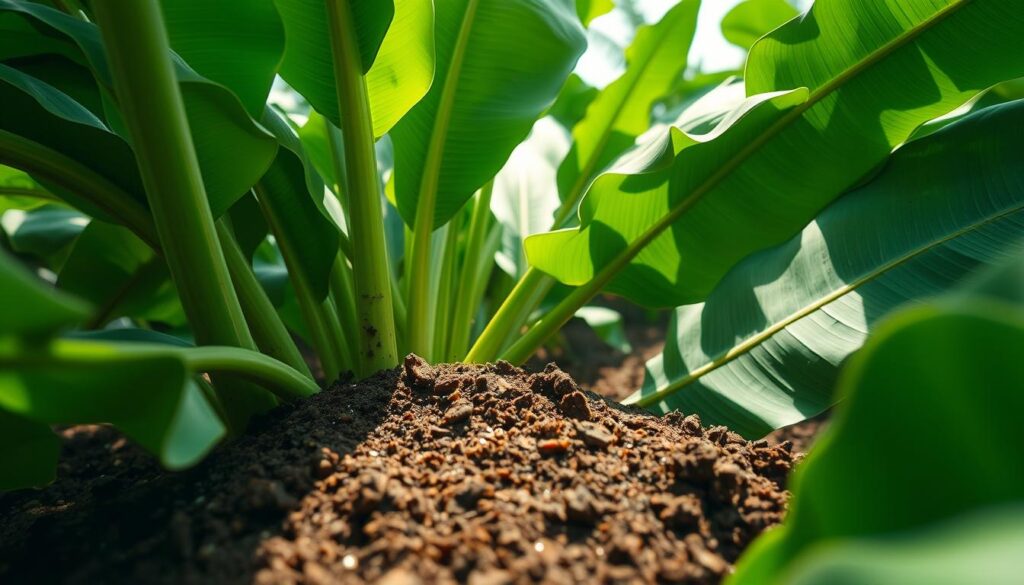
- Use a balanced fertilizer with a ratio of 8-10-10 or 15-15-15
- Feed young plants every month and mature plants every two weeks
- Reduce feeding frequency during cooler months
- Soil tests can help identify nutrient deficiencies
By following these tips, you can help your banana plant grow and produce fruit. Always take good care of your plant. Adjust how often you feed it to make sure it gets the best care.
Pruning Your Banana Plant
Pruning your banana plant is key to keeping it healthy and fruitful. It helps get rid of dead leaves and stops diseases. Start by cutting off any dead or damaged parts. Then, trim the plant back to about 30 inches tall after it stops making fruit.
For more tips on pruning, check out this website. It has a detailed guide on how to prune banana plants. Pruning encourages new growth and more fruit. It’s best to prune during the growing season or after you’ve picked all the fruit.
Some good things about pruning include:
- Improved fruit production
- Enhanced plant appearance
- Increased plant health
By pruning regularly, your banana plant will stay healthy and strong. Always use clean, sharp tools. Make cuts at a 45-degree angle to avoid water buildup. With the right care, your banana plant will give you yummy fruit and look beautiful.
Propagation Techniques for Banana Plants
There are many ways to grow banana plants, like division, tissue culture, and seeds. Knowing how to do each helps you grow more plants. It’s key to know what each method needs for banana plant care.
Division is a simple way to grow banana plants. You take small shoots from a big plant in spring. Tissue culture is harder. It needs special tools and grows plants in a clean space.
Here are tips for growing banana plants:
- Choose healthy parent plants with no disease or pests.
- Use a potting mix that drains well and a big enough pot for the roots.
- Water well after planting and keep the soil moist for a few weeks.
- Keep the temperature between 75-85°F (24-29°C) for best growth.
By following these tips and picking the right method, you can grow healthy banana plants. You can then share them with others.
| Propagation Method | Description | Difficulty Level |
|---|---|---|
| Division | Separating small suckering shoots from the parent plant | Easy |
| Tissue Culture | Growing plants in a sterile environment | Complex |
| Seed Propagation | Growing plants from seeds | Slow and Unpredictable |
Common Pests and Problems
When you take care of your banana plant, watch out for pests and diseases. Banana plant pests like aphids, spider mites, and mealybugs can harm it. Banana plant diseases like Panama wilt and leaf spot can be very bad.
Look out for yellow leaves, black crown tissue, and curled leaves. Catching these problems early is key. Talking to a County Extension Agent can help a lot.
Here are some pests and diseases to watch for:
- Aphids: small, pinhead-sized insects that cluster on stems and under leaves
- Spider mites: tiny, spider-like insects that cause yellowing or bronzing of leaves
- Mealybugs: small, white, cottony insects that feed on plant sap
- Panama wilt: a fungal disease that causes yellowing and wilting of leaves
- Leaf spot: a fungal disease that causes light yellowish spots on leaves
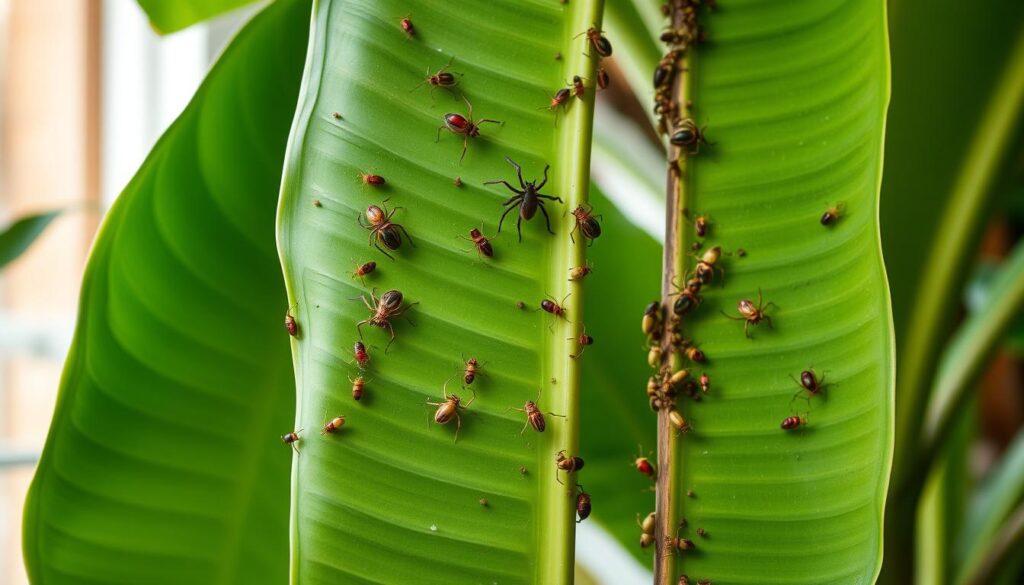
Knowing about these pests and diseases helps keep your banana plant healthy. It will grow strong and look great.
| Pest/Disease | Symptoms | Control Measures |
|---|---|---|
| Aphids | Curled, shriveled foliage | Neem oil, insecticidal soap |
| Spider mites | Yellowing or bronzing of leaves | Increased humidity, insecticidal soap |
| Mealybugs | White, cottony patches on leaves | Neem oil, insecticidal soap |
Repotting Your Banana Plant
As you care for your banana plant, you’ll need to repot it soon. This is key for its growth and health. You’ll know it’s time when the roots fill the pot or when the plant leans too much.
Choose a new pot that’s just a bit bigger than the old one. This keeps the soil from getting too wet. Use a mix that drains well for your banana plant’s health. The new pot should be a few inches wider, and the soil mix should include potting soil, perlite or sand, and compost or manure.
- Repot every 1 to 2 years for best growth
- Water well after repotting, but only when the top inch of soil is dry
- Keep the temperature between 60-70°F (15-21°C) after repotting
- Make sure the soil drains well to avoid root rot
Follow these tips to repot your banana plant right. Wait about 4 weeks before fertilizing again. Water only when the top inch of soil is dry to avoid too much water.
Seasonal Care for Banana Plants
When you care for your banana plant, think about the seasons. In winter, your plant needs special care. Winter care for banana plants means less water and food. Move your plant inside if it’s cold outside to keep it safe.
To get your banana plant ready for winter, do these things:
- Water it 3-4 times a week
- Don’t feed it during winter
- Move it inside or protect it from cold
Changing your banana plant care with the seasons helps it grow. Banana plants take time to wake up from sleep. When it’s safe outside, start watering and feeding again. With the right winter care for banana plants, you’ll enjoy its leaves and fruit all year.
| Season | Care Requirements |
|---|---|
| Winter | Reduce watering and fertilization |
| Spring | Gradually reintroduce regular watering and fertilization |
| Summer | Provide full sun and regular watering |
| Fall | Prepare for winter by reducing watering and fertilization |
Enjoying Your Indoor Banana Plant
Now that you’ve taken good care of your indoor banana plant, it’s time to enjoy it. Place it where it can be seen or use it as a centerpiece. Its big, shiny leaves and tall growth will make your home feel like the tropics.
Think about sharing your banana plant’s journey online. You can connect with other plant lovers on social media or in online groups. This way, you can share your experiences and learn new things to keep your plant healthy.
By following the care tips in this article, you’ll enjoy your banana plant for years. You can show it off or join a plant community. Either way, your banana plant will add a tropical touch to your home.
If you want to see other large statement plants that will make your indoor garden standout visit our article on 10 Stunning Large Indoor Plants for Statement Decor.


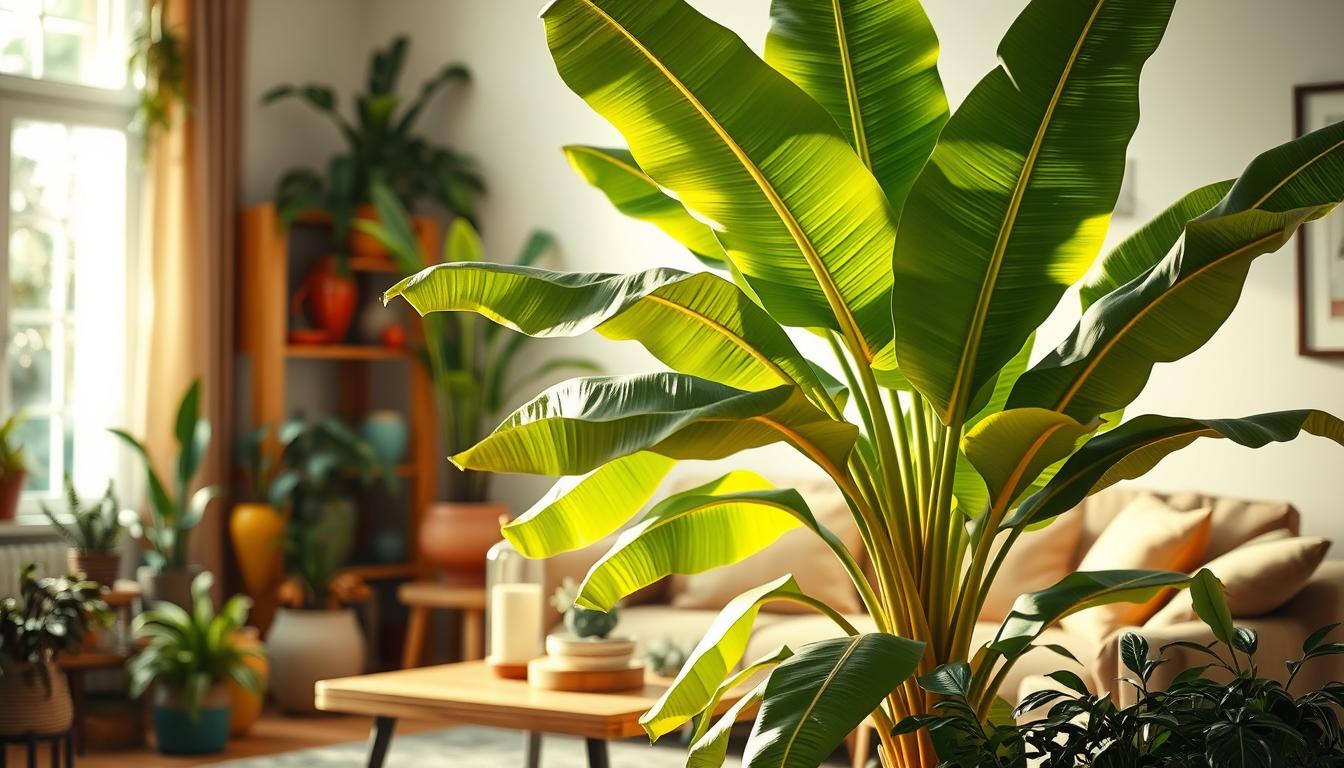
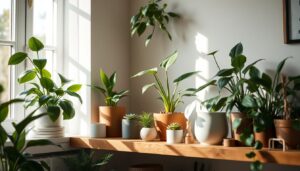
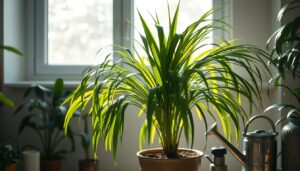

Pingback: The Ultimate Guide to Houseplants: 100 Best Indoor Plants for Every Home - Trusted House Plant Guide
Pingback: 10 Stunning Large Indoor Plants for Statement Decor - Trusted House Plant Guide